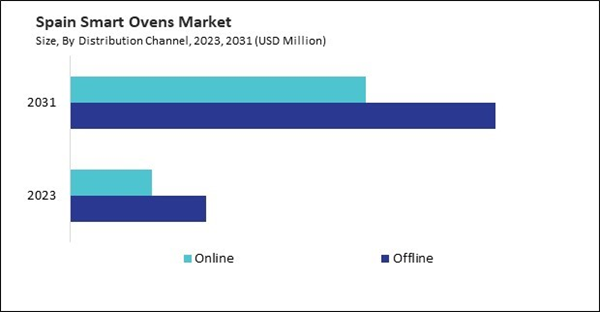Offline distribution channels play a crucial role in the smart oven market by providing consumers with opportunities for hands-on interaction, personalized assistance, and immediate gratification. While online sales are increasingly popular, offline retailers such as appliance stores, home improvement centres, and kitchen specialty shops offer a tangible shopping experience that appeals to many consumers. By showcasing smart ovens in physical stores, retailers can allow customers to see, touch, and test the products before making a purchase, helping to build trust and confidence in the brand. Hence, 311.52 hundred units of smart ovens are expected to be sold Offline in France by the year 2030.
The Germany market dominated the Europe Smart Ovens Market by Country in 2023 and would continue to be a dominant market till 2031; thereby, achieving a market value of $67.4 million by 2031. The UK market is registering a CAGR of 13% during (2024 - 2031). Additionally, The France market would experience a CAGR of 15% during (2024 - 2031).
Smart ovens come with user-friendly interfaces, including touchscreens and smartphone apps, that make it easy for users to control and monitor their ovens. The interfaces often feature intuitive navigation, colorful graphics, and interactive cooking guides to enhance the user experience. Overall, smart ovens offer unparalleled convenience and time-saving benefits. They allow users to cook with precision, monitor their food remotely, and enjoy a wide range of advanced cooking features, making cooking easier and more enjoyable than ever before.
The seamless integration of smart ovens with other smart home appliances and ecosystems is becoming increasingly common. This includes working with voice assistants such as Google Assistant, Apple Siri, Amazon Alexa, and other smart kitchen appliances, lighting controls, thermostats, and security cameras. Some smart ovens are equipped with computer vision technology that can recognize different types of food and automatically adjust cooking settings accordingly. This eliminates the need for users to manually input cooking times and temperatures, making cooking even more convenient and hassle-free.
Due to the growing multifunctionality of smart ovens, a single appliance can perform many cooking methods. In addition to traditional baking, roasting, and broiling, smart ovens may support air frying, steaming, dehydrating, and sous vide cooking. Voice control and gesture recognition technologies are becoming increasingly common in smart ovens, allowing users to control their ovens using voice commands or hand gestures.
Spain has experienced rapid growth in e-commerce, with an increasing number of consumers shopping online for a wide range of products, including home appliances like smart ovens. E-commerce offers Spanish consumers the convenience of shopping from anywhere, anytime, without needing to visit physical stores. E-commerce platforms allow Spanish consumers to access reviews and ratings from other buyers, helping them make informed purchasing decisions. E-commerce platforms make it easy for Spanish consumers to compare different smart oven models based on price, features, and customer reviews.
According to the International Trade Administration, the number of e-commerce consumers in Spain reached 30 million in 2021. eCommerce penetration was estimated at 63%, and internet penetration at 83% in 2021. By 2025, there will be 37 million eCommerce users, a 25% increase. Thus, all these factors will uplift the regional market’s expansion in the coming years.
Based on Type, the market is segmented into Counter-top, and Built-in. Based on Distribution Channel, the market is segmented into Offline, and Online. Based on End User, the market is segmented into Residential, and Commercial. Based on countries, the market is segmented into Germany, UK, France, Russia, Spain, Italy, and Rest of Europe.
List of Key Companies Profiled
- LG Electronics, Inc. (LG Corporation)
- Whirlpool Corporation
- Sharp Corporation
- Hitachi, Ltd.
- Robert Bosch GmbH
- Panasonic Corporation
- Samsung Electronics Co., Ltd.
- Techtronic Industries Co., Ltd.
- Tovala
- June Life, Inc.
Market Report Segmentation
By Type (Volume, Hundred Units, USD Billion, 2020-2031)- Counter-top
- Built-in
- Offline
- Online
- Residential
- Commercial
- Germany
- UK
- France
- Russia
- Spain
- Italy
- Rest of Europe
Table of Contents
Companies Mentioned
- LG Electronics, Inc. (LG Corporation)
- Whirlpool Corporation
- Sharp Corporation
- Hitachi, Ltd.
- Robert Bosch GmbH
- Panasonic Corporation
- Samsung Electronics Co., Ltd.
- Techtronic Industries Co., Ltd.
- Tovala
- June Life, Inc.









